Queensborough student researchers stretch beyond the stars
With deep learning experiences and self-directed learning, students’ undergraduate research projects shine.
75 Undergraduate research projects ‒ representing nine departments and featuring over 130 students ‒ were presented at Queensborough Community College’s 4th annual Undergraduate Research Day/Showcasing Faculty-Mentored Undergraduate Research Across the Disciplines on Friday, December 6th.
Topics ranged from Native American Post-Impressionist Art, the stock market and mental well-being to sexual assault, digestive health, blackholes in the Milky Way and more.
“Applied experiential learning and conducting research are things you may not associate with community college,” Queensborough President Dr. Tim Lynch told students, as they prepared to present their results, “But at Queensborough, they are ingrained in nearly everything that we do and set you apart, especially from other applicants to four-year and Masters programs.”
Dr. Lynch congratulated students for responding to the challenge and accepting the responsibility of hard work that will have a lasting influence on them as they prepare for advanced studies and careers.
“Doing research engages you, wholly. You start thinking about yourself differently. Career trajectories change. You develop writing, public-speaking, and other skills that are beneficial to anything you pursue,” Dr. Lynch added.
Held in the Student Union building, exhibitors displayed and explained their research to attendees who inquired about their posted results and findings.
Students represented Art and Design, Biological Sciences and Geology, Chemistry, Engineering Technology, History, Mathematics and Computer Science, Nursing, Physics, Social Sciences, and Speech Communications & Theatre Arts departments.
Some investigations pertained to New York City Parks; viruses that infect bacteria; the regulation of fatty acids and sugar in the body; and the effectiveness of probiotics. Others had practical applications for pharmaceutical, industrial pollution containment/clean-up, energy storage and other industries.
About two-thirds of the presentations were independent research projects according to Dr. Shiang-Kwei Wang, Director of the CUNY Research Scholars Program and Dean for Research, Office of Academic Affairs at Queensborough.
“We are so proud of our students and deeply appreciative of our Faculty mentors,” Dr. Wang remarked to the packed exhibition hall.
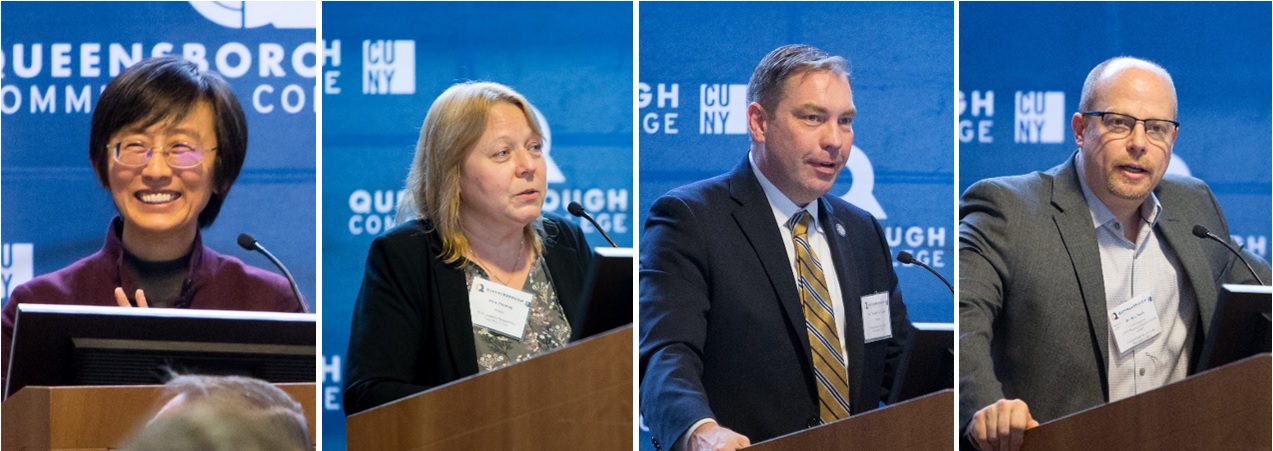
Pictured Dr. Shiang-Kwei Wang, Director of the CUNY Research Scholars Program and Dean for Research, Office of Academic Affairs; Dr. Joan Petersen, Associate Professor, Biological Sciences and Geology, and High Impact Practices Undergraduate Research Coordinator; Dr. Tim Lynch, President, Queensborough Community College; Dr. Ron Nerio, Visiting Research Program Director from the CUNY Office of Research.
“Mentors instruct, advise, ensure that you have authentic research learning experiences, build your knowledge and increase your confidence. When you get your Nobel Prize, don’t forget us.”
Visiting Research Program Director, Dr. Ron Nerio, from the CUNY Office of Research, complimented Queensborough students and staff for their “amazing energy” and commitment to research excellence.
“Queensborough has definitely been noticed throughout CUNY ‒ the real dedication you have to research, year after year,” Dr Nerio told undergraduates and Faculty, adding that 1200 students had graduated from the CUNY Research Scholars Program since its inception in 2016.
Among the presenters were Queensborough researcher partners, Jahmel Saltus and Joshua Olatunji, mentored by Assistant Professor Dr. Jillian Bellovary. The students applied a computer simulation to space, observing how smaller black holes in spiraling orbits are consumed by our galaxy’s super massive black hole.
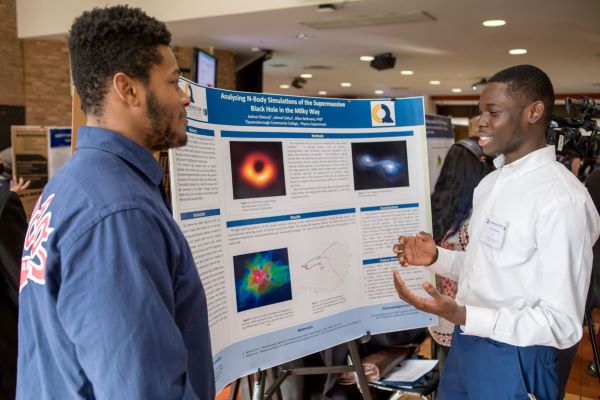
Picture: Jahmel Saltus and Joshua Olatunji observed how smaller black holes in spiraling orbits are consumed by our galaxy’s super massive black hole.
“We looked at physical properties like mass as well as space and time,” Joshua explained.
The pair developed a love for the stars as children. Saltus, from Staten Island, remembers gazing skyward on drives from the back seat of the family car and asking his mom why the moon always chased him. In Nigeria, Olatunji always thought life must exist elsewhere, given the billions of galaxies that surround us. Both up and coming physicists plan careers in space science and exploration.
Md Nazif Alam, from Bangladesh, used a different type of computer simulation to forecast something earthly: the value of Dow Jones Industrial stocks. He wanted to see if unsupervised machine learning, or artificial intelligence, could determine how stocks would behave. Having observed a positive result, he will see if he can successfully repeat the experiment using different data.
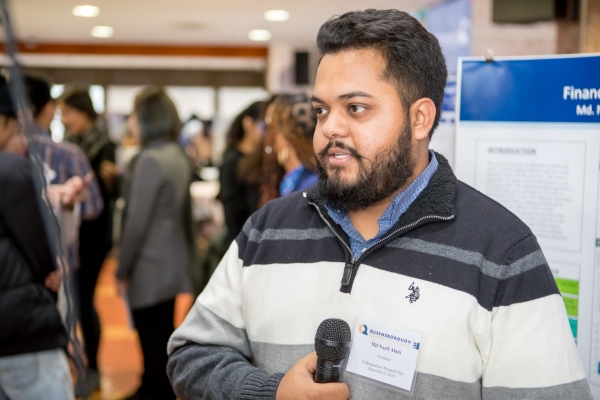
Picture: Md Nazif Alam took stock in the Dow Jones Industrials.
“The results are statistically significant, but I need to do more research to see if the results are solid. We may be able to provide a good tool that helps people evaluate the stock market,” says Alam, who already holds an overseas Bachelor’s Degree in Finance. As a non-matriculating Queensborough student, he will use his non-credit research experience (supervised by Assistant Professor Dr. Yusuf Danisman) to bolster his applications for postgraduate studies in Business Analytics or Data Science and, later, work on Wall Street.
Jordan Graham and Umit Muradi, mentored by Dr. Sarbani Ghoshal, collaborated with researchers at the Saint Louis University School of Medicine on the function of a peptide, called adropin, which acts like a hormone. They found evidence that adropin is associated with the amount of fat stored in the liver and observed that adropin also has a role in helping the brain heal from injuries.
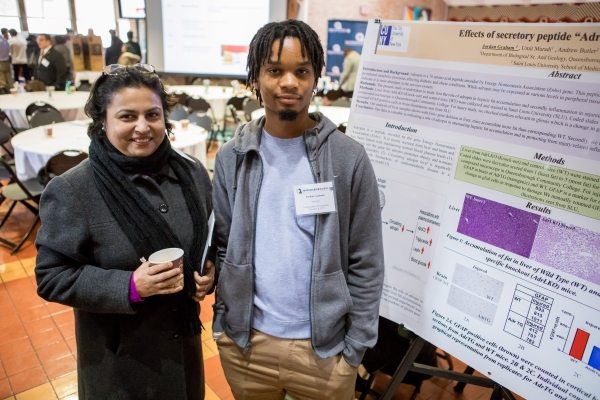
Picture: Dr. Sarbani Ghoshal mentored Jordan Graham as he researched adropin’s effect on fat storage in the liver.
“Jordan and Umit, like most undergraduate researchers, are disciplined and motivated. They want to do better,” said Dr. Ghoshal, a biologist and molecular epidemiologist who has conducted and supervised research at the The Scripps Research Institute, Saint Louis University School of Medicine and the University of Kentucky.
“The hands-on experience as a first-time researcher is enchanting. Students feel learning and that is so important. They are also developing new knowledge, or new information, that others will rely on,” Dr. Ghoshel added.
Researcher Brittany Mighty, who will train with the US Army next year, explored the use of cannabis tea as a natural, organic, antidepressant.
Supported by Associate Professor Dr. Anissa Moody, Mighty drew on a library of published reports and anecdotal evidence about the benefits of medicinal marijuana and hypothesized that liquid cannabis would be effective without the euphoria brought on by smoking.
“The plant contains more than 100 different chemicals called cannabinoids. The cannabis is steeped in hot water and then it is consumed,” explained the Jamaican-born psychology student and future health professional.
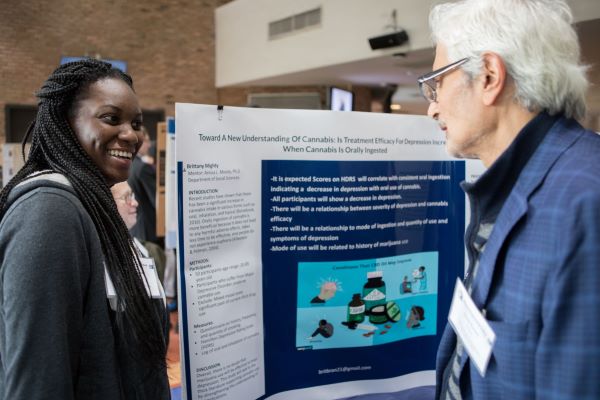
Picture: Brittany Mighty explains her research on cannabis tea.
“This research excites me. When I am a nurse I want to understand what my patients are experiencing and feeling, not sit in judgement of them.”
Dr. Celia Sporer (who was born and raised in Queens, often visited Queensborough while at school, and is a CUNY graduate) supervised first year Criminal Justice student Emely Gutierrez Mora’s research on sexual violence on American college campuses.
“I tell all of my students that everything today is evidence based and research based. Skills learned by doing research are transferable,” said Sporer.
Most undergraduates are tentative about doing research, according to Sporer, but they need to know that research is something they can do, with the support of Queensborough Faculty.
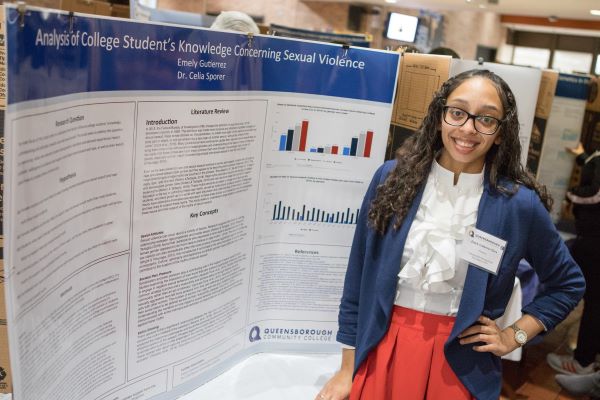
Picture: Emely Gutierrez Mora is researching sexual violence on college campuses.
“It’s as scary as can be, but professors have their backs. Nobody is born knowing how to do research. Most people need guidance and that’s what we’re here for.” Sporer added.
“In the end, they develop a real sense of accomplishment. When they see their data and finalize their reports, the smiles are genuine. Students stand up straighter, present themselves better, and know themselves better.”
A dozen Engineering projects were prepared for Undergraduate Research Day, three of which were robots designed to obey traffic lights, sort products, and autonomously recover dangerous waste or other materials.
Emerging researcher and engineer Keana Gilles, from Nassau County, designed her device to handle hazardous conditions.
“We had to learn the programming language. There was a lot of trial and error and testing of functions,” explained Gillis. As a child, she admitted to “sometimes getting into trouble for taking electronic devices apart.”
Floral Park’s Souvik Saha, another mechanical engineer, helped design and construct a device envisaged to retrieve trash.
“When I was younger I had a knack for computers. When I started here, I wasn’t sure what my major would be but I became fascinated with robotics,” he said, setting his automated vehicle on a tabletop mission to identify and pick up a soft ball. It did.
Professor Dr. Hamid Namdar and Assistant Professor Dimitrios Stroumbakis mentored students on these projects.
Undergraduate Research, a hallmark of Queensborough, is a High Impact Practice that includes traditional student-mentor partnerships, designated research courses and research in the classroom according to Dr. Joan Petersen, Associate Professor, Biological Sciences and Geology, and High Impact Practices Undergraduate Research Coordinator.
The event was established at Queensborough in 2016 and led by Professor Sharon Lall-Ramnarine, Department of Chemistry, then the coordinator for Undergraduate Research as a High Impact Practice and campus director for the CUNY Research Scholars Program (CRSP).
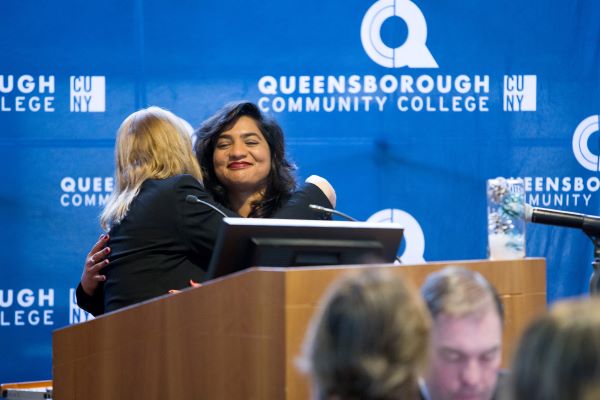
Picture: Present and former Queensborough High Impact Practices Undergraduate Research Coordinators; Dr. Joan Petersen (left) embraces Dr. Sharon Lall-Ramnarine, acknowledging Dr. Lall-Ramnarine’s role in strengthening the College’s undergraduate research outcomes.
Earlier this year, the Middle States Commission on Higher Education commended Queensborough for its High Impact experiential learning. The College’s programs enrich students’ education and lead to successful transfers, according to its March report. “[T]he academic rigor of [Queensborough’s] curriculum approach can be seen in the annual Undergraduate Research Day,” authors concluded.
The College’s research programs feature Bridges to the Baccalaureate Programs: Research Initiative to Maximize Science Skills, established in 2002 to develop 15 under-represented science students, annually, for further education and careers in fields such as biology, chemistry, math, physics and behavioral science. Over 80% of students in the program have advanced in the sciences, receiving Bachelor and Master’s degrees, including six PhD’s, four medical doctors, and four doctors of pharmacology. 39 Master’s degrees have also been awarded to program participants.
Other specialized research programs are:
- The Community College Undergraduate Research Initiative (supported by the National Science Foundation);
- The Collegiate Science and Technology Entry Program (supported by the New York State Department of Education);
- The Summer Intensive Research Program (supported by CUNY Research Central, and Queensborough’s Department of Social Sciences and Office of Academic Affairs);
- The Space Weather Research and Education Program (a partnership with NASA Goddard, City College and Atmospheric & Space Technology Research Associates);
- The CUNY Research Scholars Program at Queensborough;
- The National Science Foundation Research Experience for Undergraduates;
- The NSF S-STEM Scholars Program in Smart Energy; and
- The Kupferberg Holocaust Center Student Engagement program.
“Undergraduate research in all fields is demanding. It is full of false starts and misdirection and, as we see, it encourages students to be creative and patient. It is provides great preparation for any education pathway or career,” stated President Lynch.
###
Contact:
Michael Donahue or Alice Doyle



